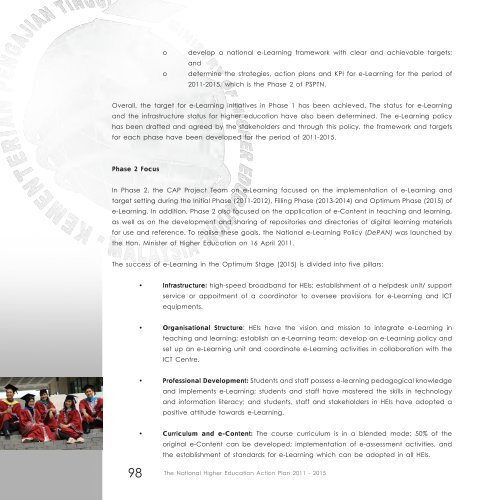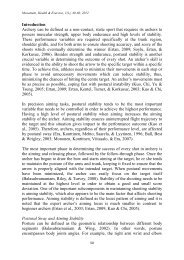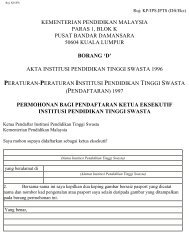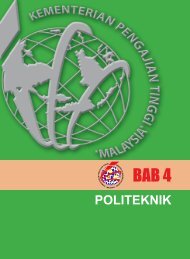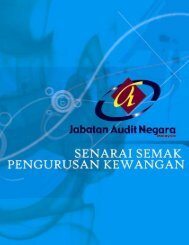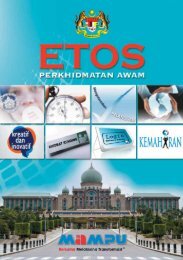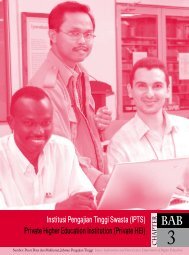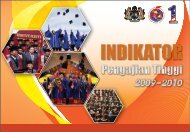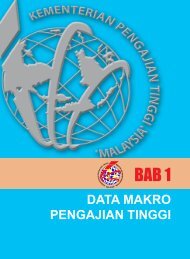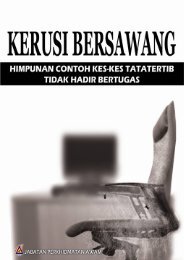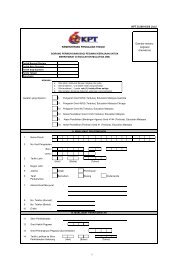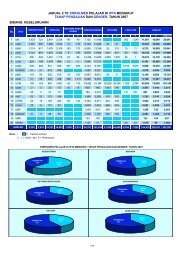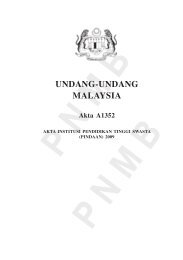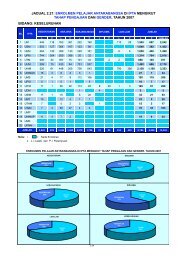STRATEGIC PLAN - Kementerian Pengajian Tinggi
STRATEGIC PLAN - Kementerian Pengajian Tinggi
STRATEGIC PLAN - Kementerian Pengajian Tinggi
- No tags were found...
You also want an ePaper? Increase the reach of your titles
YUMPU automatically turns print PDFs into web optimized ePapers that Google loves.
oodevelop a national e-Learning framework with clear and achievable targets;anddetermine the strategies, action plans and KPI for e-Learning for the period of2011-2015, which is the Phase 2 of PSPTN.Overall, the target for e-Learning initiatives in Phase 1 has been achieved. The status for e-Learningand the infrastructure status for higher education have also been determined. The e-Learning policyhas been drafted and agreed by the stakeholders and through this policy, the framework and targetsfor each phase have been developed for the period of 2011-2015.Phase 2 FocusIn Phase 2, the CAP Project Team on e-Learning focused on the implementation of e-Learning andtarget setting during the Initial Phase (2011-2012), Filling Phase (2013-2014) and Optimum Phase (2015) ofe-Learning. In addition, Phase 2 also focused on the application of e-Content in teaching and learning,as well as on the development and sharing of repositories and directories of digital learning materialsfor use and reference. To realise these goals, the National e-Learning Policy (DePAN) was launched bythe Hon. Minister of Higher Education on 16 April 2011.The success of e-Learning in the Optimum Stage (2015) is divided into five pillars:• Infrastructure: high-speed broadband for HEIs; establishment of a helpdesk unit/ supportservice or appoitment of a coordinator to oversee provisions for e-Learning and ICTequipments.• Organisational Structure: HEIs have the vision and mission to integrate e-Learning inteaching and learning; establish an e-Learning team; develop an e-Learning policy andset up an e-Learning unit and coordinate e-Learning activities in collaboration with theICT Centre.• Professional Development: Students and staff possess e-learning pedagogical knowledgeand implements e-Learning; students and staff have mastered the skills in technologyand information literacy; and students, staff and stakeholders in HEIs have adopted apositive attitude towards e-Learning.• Curriculum and e-Content: The course curriculum is in a blended mode; 50% of theoriginal e-Content can be developed; implementation of e-assessment activities, andthe establishment of standards for e-Learning which can be adopted in all HEIs.98The National Higher Education Action Plan 2011 - 2015


